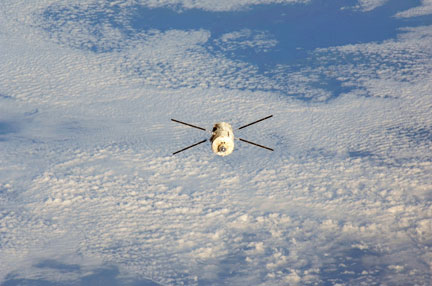
Photo of ATV-1 leaving ISS, courtesy of ESA
As for the first Jules Verne ATV, which completed its mission in 2008, and the Johannes Kepler ATV, set for launch in early 2011, the Edoardo Amaldi ATV will now undergo a series of integrated tests. It will then be shipped to the Guiana Space Center in Kourou, French Guiana for a scheduled early 2012 launch to the International Space Station. The unmanned ATV will automatically dock with the ISS, so it can transfer experimental equipment, spare parts, food, air and water for the crew. In addition to the three tons of cargo carried by the pressurized ICC module, built by Thales Alenia Space, it will also bring over two tons of fuel to reboost the Space Station, plus 860 kg of ISS refuel propellant, up to 540 of water, also produced in Turin by SMAT, and over 100 of gas. The ATV cargo transfer operations will be carried out by the ISS crew using control and monitoring systems in the ICC, also developed by Thales Alenia Space.
The third ATV-ICC module built by Thales Alenia Space comprises a pressurized cylinder 4.6 meters in diameter and 4 meters long, including the ISS docking system at the front, and a non-pressurized area 0.7 meters long including the refueling system and the water and oxygen supply tanks. The sensors, antenna and some part of the attitude control thrusters for navigation and the ISS docking phase, are integrated in the ICC module. All electronic control equipment for ISS docking phase is integrated in the ICC module. This equipment is adapted from components used on Russia’s Progress and Soyuz vehicles, and was supplied by RSC-Energia.

